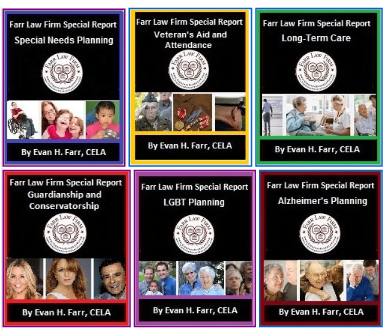2016 Key Medicaid Dollar Amounts
Published: Fri, 12/11/15
 |
2016 Key Medicaid Dollar AmountsIf you cannot view the image below, please read the article on our blog. Q. Every year your firm provides the key dollar amounts that are frequently used in elder law, including Medicaid figures, long-term care insurance deductibility limits, Medicare premiums, Social Security Disability, and Supplemental Security Income. Are these figures available for 2016 yet and, if so, can you tell me what some of the changes are for the coming year? Thank you very much!
A. Yes, most of these figures have been released and we are happy to provide details on what has changed for the coming year! The complete 2016 dollar amounts are available on our website. Be sure to check back often, as we will add any information that has not yet been released and update the page should any changes occur (e.g. the
Minimum Monthly Income Allowance adjustment is updated annually on July 1).
2016 Medicaid Figures:
In 2015 and continuing into 2016, states remain focused on strategies and initiatives to improve the effectiveness and outcomes of care, and to slow the growth in the cost of care. For this coming year, state Medicaid programs are looking for opportunities to leverage other resources and stakeholders (such as state public health agencies and other payers) to improve the quality of care provided, control rising
prescription drug costs, and ultimately affect health outcomes for the populations they serve. According to the Kaiser Family Foundation's "Medicaid Reforms to Expand Coverage, Control Costs and Improve Care: Results from a 50-State Medicaid Budget Survey for State
Fiscal Years 2015 and 2016" report, "pursuing these significant goals has caused Medicaid to evolve into a major player in transforming the overall health care system."
When it comes to key dollar amounts, the amounts that have changed are denoted below. Please keep in mind that the Medicaid Divestment Penalty Divisor for Northern Virginia and the rest of the state has not yet been released. Neither has the Monthly Personal Allowance for Elderly or Disabled with Consumer Direction (EDCD) or the Utility Standard. We will update our website as soon as this information becomes
available.
Spousal Impoverishment Standards
Minimum Community Spouse Resource Allowance (For all states, except Alaska and Hawaii)
2016: $23,844 2015: SAME Maximum Community Spouse Resource Allowance (For all states, except Alaska and Hawaii)
2016: $119,220 2015: SAME Maximum Monthly Maintenance Needs Allowance (For all states, except Alaska and Hawaii)
2016: $2,980.50 2015: SAME Minimum Monthly Income Allowance (For all states, except Alaska and Hawaii): The total Minimum Monthly Income Allowance remains at 1,991.25 – it will be adjusted on July 1, 2015.
Shelter Standard:
2016: $597.38 (Virginia)
$590 (Maryland) DC will be updated on our website, when available. 2015: $589.88 (Virginia) SAME (Maryland) DC will be updated on our website, when available. Home Equity Cap: (These amounts are based on Medicaid.gov's Spousal Impoverishment numbers for 2016. 2016 Home Equity Caps for Virginia, Maryland, and DC will be updated on our website, when available)
Minimum: $552,000 Maximum: $828,000 Medicare
Medicare has been protecting the health and well-being of American families and saving lives for five decades. Last month, President Obama signed the Balanced Budget Act (BBA) into law, which among other things, averted a pending premium hike for many Medicare enrollees, extended a 2% cut in payments to Medicare providers, and limited outpatient payouts under the popular seniors program. Read more about the
specifics of the BBA in our recent blog post, "Balanced Budget Act: Good or Bad for Seniors?"
Below are the numbers that have changed for the coming year:
Medicare Deductibles, Premiums and Co-pays
Medicare Part A Deductible
2016: $1,288 deductible for each benefit period
2015: $1,260 deductible for each benefit period Medicare Part A Premium
Most people don’t pay a monthly premium for Part A. However,
if you are one of the small number of people who don’t qualify for free Part A coverage and decide to purchase it on your own, you’ll pay: 2016: $411 each month
2015: $407 each month
Co-payment for hospital stay, days 61-90
2016: $322 per day 2015: $315 per day Co-payment for hospital stay, days 91 and up
2016: $644 per day 2015: $630 per day Co-payment for skilled nursing facility stay, days 21-100
2016: $161 per day 2015: $157.50 per day —–
Long-Term Care (LTC) Insurance Premium Deductibility Limits In 2016, the IRS will once again increase the amounts long-term care insurance customers can deduct from their federal income taxes. The IRS’s premium deductibility limits may assist those who itemize their medical expenses. See below for the maximum deductions based on attained age before the close of the taxable year.
40 or younger
2016: $390/yr 2015: $380/yr 41 to 50
2016: $730/yr 2015: $710/yr 51 to 60
2016: $1,460/yr 2015: $1,430/yr 61 to 70
2016: $3,900/yr 2015: $3,800/yr Over 70
2016: $4,870/yr 2015: $4,750/yr Social Security and Supplemental Security Income
Monthly Social Security and Supplemental Security Income (SSI) benefits will not automatically increase in 2016, as there was no increase in the Consumer Price Index (CPI-W) from the third quarter of 2014 to the third quarter of 2015. This 0% increase was preceded by a 1.7% Cost of Living Adjustment (COLA)for 2015, 1.5% COLA for 2014, 1.7% COLA for 2013, 3.7% adjustment in 2012, and a 0% adjustment in 2010 and
2011.
—-
Social Security Disability Thresholds Substantial Gainful Activity (SGA)
Non-Blind
2016: $1,130/mo. 2015: $1,090/mo. Blind
2016: $1,820/mo 2015: $1,820/mo Maximum Social Security Benefit:
Worker Retiring at Full Retirement Age 2016: $2.639/mo. 2015: $2.663/mo. SSI Federal Payment Standard
Individual 2016: $733/mo. 2015: SAME Couple
2016: $1,100/mo. 2015: SAME Estimated Average Monthly Social Security Benefits Payable in January 2016
All Retired Workers
2016: $1,341 2015: $1,328 Aged Couple, Both Receiving Benefits
2016: $2,212 2015: $2,176 Widowed Mother and Two Children
2015: $2,680 2014: $2,535 Aged Widow(er) Alone
2016: $1,285 2015: $1,274 Disabled Worker, Spouse and One or More Children
2016: $1,983 2015: $1,976 All Disabled Workers
2016: $1,166 2015: $1,165 Thank you for your interest in these key dollar amounts for 2016. We hope this was helpful! We also hope to see you this month or in the new year at one of our seminars in 2016. As always, if you or a loved one is nearing the need for long-term care or already receiving long-term care, or if you have not done Long-Term Care
Planning, Estate Planning or Incapacity Planning (or had your Planning documents reviewed in the past several years), please call us to make an appointment for an initial no-cost consultation:
Fairfax Elder Law Attorney: 703-691-1888
Fredericksburg Elder Law Attorney: 540-479-1435 Rockville Elder Law Attorney: 301- 519-8041 DC Elder Law Attorney: 202-587-2797 --------
Critter Corner: Are Estate Planning Services Tax Deductible?
|
|
||
|
This email was sent to
.
|











